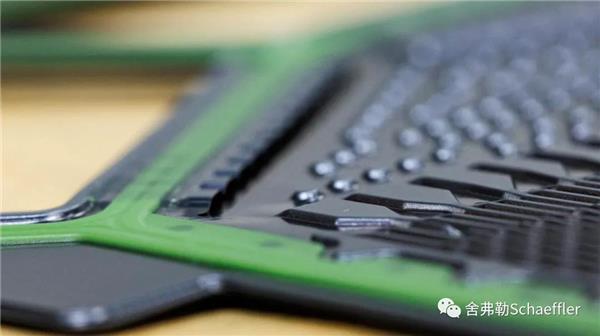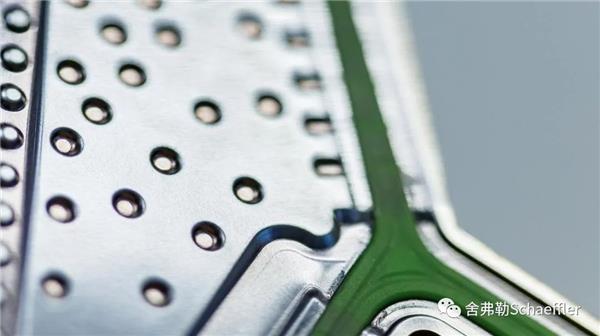IAA Mobility 2023 | Schaeffler launches next-generation bipolar plates
At a purpose-built pilot production facility in Herzogenaurach, the company is now manufacturing the new plates in runs of up to several tens of thousands of units for use by international vehicle manufacturers in prototype and small-series production. The fully automated facility is part of Schaeffler’s center of excellence for hydrogen, a complex that also includes an extensive array of testing equipment.

Schaeffler is manufacturing plates at a purpose-built pilot production facility in Herzogenaurach
The facility has been designed so that it can also be used to manufacture large plates of the type used for electrolyzers. Schaeffler is thus ensuring both sustainable motion and the sustainable supply of green hydrogen. Thanks to its systems expertise, Schaeffler is also able to partner with customers to develop customized bipolar plates and components for fuel cell systems. Schaeffler is due to start production of bipolar plates under the name of Innoplate, a joint venture with Symbio, in Haguenau, France, at the start of 2024.
New design for increased power density
To the untrained eye, bipolar plates aren’t much to look at, being only about the size of a DIN A4 envelope and weighing just 60 grams. But they are core components of fuel cells, where they perform a number of vital functions, including providing channels both for the separation and distribution of the process gasses and coolant and for the removal of the water resulting from the chemical reaction.
“Schaeffler has developed an innovative design that makes optimal use of the plate’s surface area,” explained Dr. Jochen Schröder, Schaeffler’s head of E-Mobility. “The finer and more precise the structures on the bipolar plate, the more efficient the plate is.” Schaeffler’s new plates enable a fuel cell stack power density of 4.6 kW per liter of fuel cell volume (including end plates and compression hardware).

Fuel cell stacks made using the new Schaeffler plates can achieve a power density about 20 percent greater than that of stacks made using previous-generation plates
For vehicle applications, several hundred of these plates are layered on top of one another, each separated by a membrane electrode assembly (MEA), to form a stack. The plates account for up to 80 percent of the stack’s weight, and up to 65 percent of its volume. Stacks comprising up to 400 of these cell units have a total power output of up to 140 kW – enough for light commercial vehicles. Heavy commercial vehicles up to 40 tons generally require two stacks.
Industrial-scale production
Schaeffler’s new generation of bipolar plates is also designed from the ground up for industrialization at large scale – an approach known as design for manufacturing (DFM). The aim is to achieve a level of cost-effectiveness and scalability of manufacturing sufficient for hydrogen-powered mobility to reach market breakthrough. In terms of production, the company is leveraging its many years of experience and expertise in metal stamping and forming, and has achieved the high level of precision needed to stamp the necessary ultrafine structures on the surface of the plates, which have a thickness of only 50 to 100 micrometers.

The key determinant of a plate’s performance is the design of its surface: the finer and more precise the structures on the plate, the more efficient it is
Another unique feature of the metallic bipolar plates made by Schaeffler is the coating system used. The purpose of coatings is to maintain a high level of electrical conductivity over the fuel cell’s entire service life. Schaeffler’s solution is “Enertect” – a family of high-performance coating systems developed specifically for bipolar plates. Depending on the customer’s requirements, the coatings can be engineered for maximum plate service life, minimum carbon footprint, or an optimized price-performance ratio.
“Thanks to our capabilities in surface technology, we are able to offer each customer an application-specific coating solution. This means we can meet each customer’s requirements in terms of balancing cost, performance, and manufacturing-related CO2 emissions,” Jochen Schröder said.

Schaeffler has designed its new generation of bipolar plates from the ground up for industrialization at large scale
The coatings are applied using a specially adapted and fine-tuned version of the physical vapor deposition (PVD) process that Schaeffler has used successfully in the production of millions upon millions of highly stressed valvetrain components over the years. And finally, to make fuel cells gas- and watertight – vital from a quality and safety perspective – Schaeffler uses either injection-molded or silk screen gaskets, or, depending on requirements, a special laser welding process developed in-house.
Gasgoo not only offers timely news and profound insight about China auto industry, but also help with business connection and expansion for suppliers and purchasers via multiple channels and methods. Buyer service:buyer-support@gasgoo.comSeller Service:seller-support@gasgoo.com







